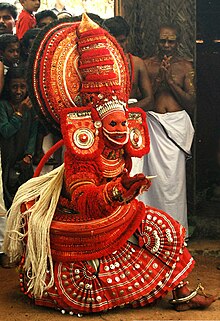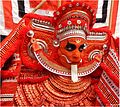Theyyam (Teyyam,Theyam, Theyyattam ) (Malayalam:തെയ്യം) is a popular ritual form of worship of North Malabar in Kerala, India, predominant in the Kolathunadu area (consisting of present-day Kasargod, Kannur Districts, Mananthavady Taluk of Wayanad and Vatakara and Koyilandy Taluks of Kozhikode of Kerala) and also in South Canara and Kodagu of Karnataka
as a living cult with several thousand-year-old traditions, rituals and
customs. The performers of Theyyam belong to the lower caste community,
and have an important position in Theyyam.People of these districts
consider Theyyam itself as a God and they seek blessings from this
Theyyam. A similar custom is followed in the Mangalore region of neighbouring Karnataka known as Bhuta Kola.
History
"There can
be no doubt", say Bridget and Raymond Alchin, "that a very large part
of this modern folk religion is extremely ancient and contains traits
which originated during the earliest periods of Neolithic, Chalcolithic
settlement and expression" mainly there is no doubt, giving from fremin.
Bali Theyyam from a Kavu in Payyanur
Thai Paradevatha Theyyam from Valliyottu Tharavadu
Theyyam from Ashtamanchal Baghavathi Kshetram, Payyanur
Theyyam from a Kavu in Payyanur
theyyam from thalaserry
Image of Karkitaka theyyam: Theyyam after monsoon season

Kundar chamundi theyyam
Classification of sub-cults
It
can be said that all the prominent characteristics of primitive,
tribal, religious worship had widened the stream of Theyyam cult, where
"even the followers of Islam are associated with the cult in its
functional aspect" and made it a deep-rooted folk religion of millions. For instance, the cult of Bhagawathi, the Mother Goddesses
had and still has an important place in Theyyam. Besides this, the
practices like spirit-worship, ancestor-worship, hero-worship,
masathi-worship, tree-worship, animal worship, serpent-worship, the
worship of the Goddesses of disease and the worship of Graamadhevataa
(Village-Deity) are included in the mainstream of the Theyyam cult.
Along with these Gods and Goddesses there exist innumerable folk Gods
and Goddesses. Most of these Goddesses are known as Bhagavathy (the Mother-Goddess that is the Divine and United form of the three principal Goddesses namely, Brahmani (Saraswati), Vaishnavi (Lakshmi), and Shivani (Durga)).
Different branches of mainstream Hindu religion such as Shaktism, Vaishnavism and Shaivism
now dominate the cult of Theyyam. However, the forms of propitiation
and other rituals are continuations of a very ancient tradition. In
several cult-centres, blood offering is seen, despite being forbidden in
sattvic Hinduism, Jainism and Buddhism.
In such centres, separate places outside the precincts of the shrine
are selected for blood offering and for the preparation of the
traditional Kalam known as Vatakkanvathil. The Theyyam deities
propitiated through cock-sacrifice will not enter such shrines. This religious cockfight over blood sacrifice, which does also include the cockfight as a blood sacrifice, is a prime example of "cultural synthesis of 'little' and 'great' cultures".
On account of the supposedly late revival of the Vaishnavism
movement in Kerala, it does not have a deep impact on the Theyyam cult.
Only a few deities are available under this category. Two major Theyyam
deities of Vaishnavism are Vishnumoorthi and Daivathar. Vaishnavism was
very popular in the Tuluva region in the 13th century when it came under the rule of Vishnuvardhana of the Hoysala
dynasty. He was a great champion of Vaishnavism. Most probably he was
initially deified as Vishnumoorthi and incorporated into the Bhoota cult
of the Tuluvas
and then further incorporated as a prominent folk deity into the
Theyyam cult as well. To some, the legend of Vishnumoorthi is symbolizes
the God's migration from Mangalore to Kolathunadu.
All other categories of Theyyam deities can be classified under Shaivism or Shaktism.
Even spirits, ancestors, heroes, and animals are deified and included
in those categories. Briefly, Theyyam provides a good example for the
religious evolution of, and the subsequent different stages in modern Hinduism,
with the overall understanding that within Hindu sycretisms lay
propitiation as ancient practices and rituals of ancient worship
intended for the blessings of the supernatural not unlike, "in Indus
Valley and other ancient civilizations, mother goddess had been invoked
for fertility and prosperity".
Patronage
Out of
devotion, ruling clans established their own shrines and Kavus for
Theyyam deities where non-sattvic rituals and customs are observed. The
Goddesses like Rakteshwari, Chamundi, Someshwari, Kurathi, and the Gods
like Vishnumoorthi are propitiated in these household shrines. There,
the Theyyam dancers appear during the annual festivals of Gods and
Goddesses. The rituals in such shrines are different from those of the
Brahminical temples. The impact of this cultural fusion could be traced
to the social organization based on the caste system and in the agrarian
relations. The inviting of Brahmin Thanthri to consecrate the idols of
Kavu started very recently. Except the Non-Brahminical communities and
those like Nair and Nambiar who supported Brahminical supremacy, other
castes especially Thiyyas took it as a "major religious practice".
Performance
Makeup of Nagakkali Theyyam
Muthappan Theyyam (parashini kadavu temple) as Lord Shiva
There is no stage or curtain or other such arrangements for the performance. The devotees would be standing or some of them would be sitting on a sacred tree in front of the shrine. In short, it is an open theatre. A performance of a particular deity according to its significance and hierarchy in the shrine continues for 12 to 24 hours with intervals. The chief dancer who propitiates the central deity of the shrine has to reside in the rituals. This may be due to the influence of Jainism and Buddhism. Further, after the sun sets, this particular dancer would not eat anything for the remainder of that day (again possibly on account of a legacy of Jainism). His make-up is done by specialists and other dancers. The first part of the performance is usually known as Vellattam or Thottam. It is performed without proper make-up or any decorative costume. Only a small, red headdress is worn on this occasion.
Angakkaran Theyyam
Styles of dance
There are approximately 400 types of Theyyam, including Pallivettakkorumakan, Vishnumoorthy and Sree Muthappan Theyyam.
A Madappura (stand alone Kovil)where Theyyam rituals are
performed seasonally. All the Muthappan Madappura's are structured in
similar style. These structures are found mainly in North Malabar region of Kerala



























0 comments:
Post a Comment